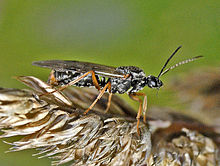Wood ant
| Formica rufa species group | |
|---|---|
 |
|
| Formica rufa worker | |
 |
|
| Formica rufa group winged male | |
| Scientific classification | |
| Kingdom: | Animalia |
| Phylum: | Arthropoda |
| Class: | Insecta |
| Order: | Hymenoptera |
| Family: | Formicidae |
| Subfamily: | Formicinae |
| Genus: | Formica |
| Species group: | F. rufa species group |
The Formica rufa group is a subgeneric group within the genus Formica, first proposed by William Morton Wheeler. This group contains the mound-building species of Formica commonly termed "wood ants" or "thatch-mound ants", which build prominent nests consisting of a mound of grass, litter, or conifer needles. The species Formica rufa or the red wood ant is the type species of this sub group.
This particular breed of ant can inhabit open wood with both hard and soft woods, dense pine forests, and even moor land. Workers are polymorphic, the largest reaching about 10 mm long. They can produce formic acid in their abdomens and eject it 12 cm in the air when threatened. The only function of males is to mate in flight with queens. Species previously attributed to the Microgyna group were transferred to the F. rufa group by the Wheelers in 1986.
The genetic relations in F. rufa group colonies can be complex. Colonies can be polygynous (having multiple queens) and these are often polydomous (having multiple nests per colony). Queens may be singly or multiply mated, and in polygynous colonies may or may not be related. Colonies are rarely, if ever, independently formed. They either bud off from existing colonies, or are formed by temporary social parasitism of F. fusca colonies; a rufa queen ousts the existing queen, lays eggs, and the fusca workers raise her offspring until the nest is taken over. Some species in the F. rufa group sometimes form enormous "supercolonies" consisting of hundreds or thousands of nests. The largest documented example is an F. yessensis colony in Japan covering 2.7 km2 containing an estimated 306 million workers and 1 million queens.
European species include:
North American species include:
...
Wikipedia
